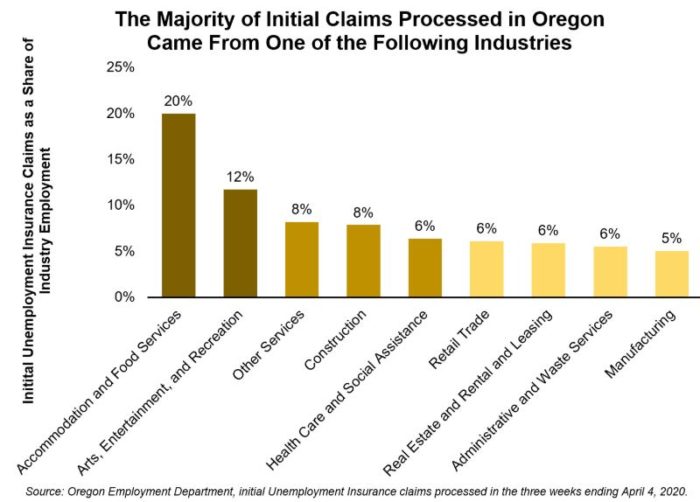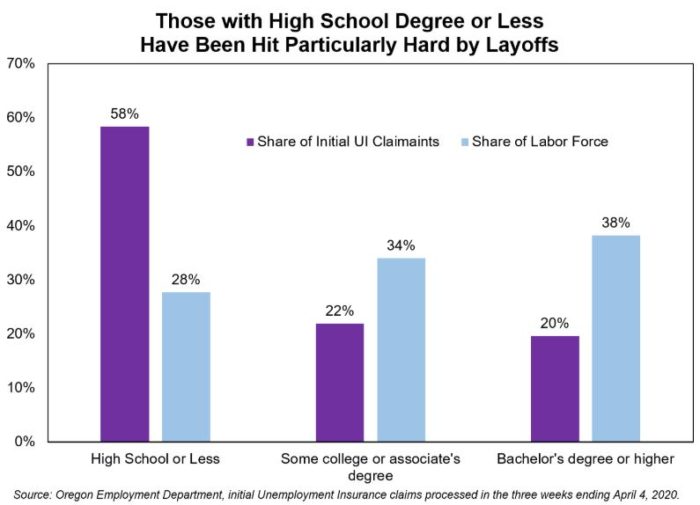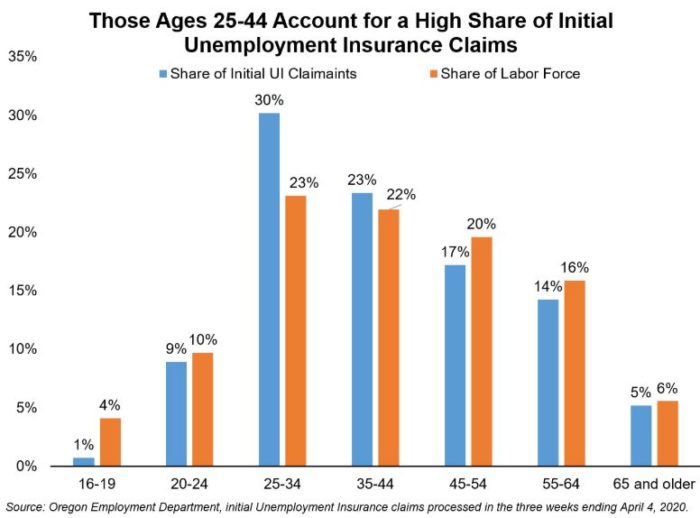Who are the Covid-19 Unemployed in Oregon?
One of the most visible and devastating impacts of the state’s stay-at-home order to protect us from the human health crisis presented by COVID-19 has been mass layoffs. Over 16 million initial claims for unemployment insurance were filed across the nation in the first three weeks of the crisis. Here in Oregon nearly 270,000 initial claims were received in those first three weeks.
During “normal” times we would typically not talk too much about unemployment insurance claims. These tend to be an unexciting dataset with little change from one month to the next. Even during our last recession that began in 2008, the increase in unemployment insurance claims was relatively gradual. The rapid onset of the COVID-19 restrictions meant that our traditional economic indicators, such as total nonfarm employment or the unemployment rate could not immediately show the severity of this economic shock. That left us with the unemployment insurance claim data as one of the few indicators in the first weeks of the shock that could help us understand the magnitude of the crisis.
We now have three weeks of processed initial claims data, which is a large enough group for us to start to draw some conclusions about industries and areas most impacted at the onset of the crisis, as well as some demographic characteristics.
Let’s start with the regional distribution of these initial unemployment insurance claims. Not surprisingly the most populated counties have the largest number of initial unemployment insurance claims, with Multnomah (29,140 claims) and Washington County (13,940 claims) in the Portland Metro area topping the list of counties with the highest number of claims processed. However, we can see a clearer picture of the hardest-hit counties by looking at the number of initial claims as a share of the total labor force. Here we see that counties with large accommodation and foodservice sectors and tourism destinations were the hardest hit. The number of initial claims processed in both Lincoln and Clatsop counties on the Oregon coast represented more than 10 percent of the labor force.
The counties least impacted three weeks into the crisis are the least populated in the state. They are likely ranked so low due to proportionally smaller concentration of local employment in restaurants or other businesses directly impacted by the COVID-19 restrictions.
As would be expected, accommodation and food services has been the hardest hit industry during the current crisis, with initial claims processed over the past three weeks representing roughly 20 percent of statewide employment in the industry. Arts, entertainment, and recreation was the next hardest hit with museums, ski resorts, zoos, and other recreation companies closing or seeing their operations significantly curtailed.
Perhaps more surprising has been the large number of initial unemployment insurance claims being processed in construction, health care, and manufacturing. These were industries that on first glance would seem more insulated from the initial COVID-19 restrictions. Health care posting large numbers of layoffs during a health crisis may seem puzzling; however, there are many health-related businesses that are not serving on the front lines of the COVID-19 response such as dentist offices, ambulatory health services, medical labs, and surgery centers. Many elective procedures are being postponed until the health crisis diminishes and there is less strain on the hospital system. Layoffs in construction and manufacturing are likely a result of an inability for many of these businesses to implement effective social distancing requirements. However, as this crisis continues, we will likely see an increase in layoffs due to a demand shock from less consumer spending. The one commonality among these hardest hit industries is an inability for many of the jobs to transition to work from home and the design of workplaces that makes social distancing difficult.
We recently published the first look at characteristics of those with recently processed unemployment insurance claims. The information shows the number of initial claims processed over the three weeks ending April 4, 2020 by age, educational attainment, gender, race and ethnicity, and occupation. It shows that the bulk of the claimants are between the ages of 25 to 44 and that those with a high school diploma or less have been particularly hard hit. However, it is important for us to analyze these impacts in the context of the size of those populations in Oregon. What groups have been hit proportionally hardest?
When comparing the level of education for today’s unemployment insurance claimants compared with the educational attainment of the entire labor force we see that those with lower levels of education have been hit particularly hard. This is likely a reflection of the industries that have been hardest hit, such as leisure and hospitality, construction, retail, and manufacturing that have a higher concentration of workers with a high school degree or less. Only around 20 percent of recent unemployment insurance claims were by individuals with a bachelor’s degree or higher, a significantly lower share than the 38 percent of the labor force they account for.
The age distribution of the unemployment insurance claimants is fairly typical of the labor force more broadly, with a few exceptions. Those ages 25 to 34 have been particularly hard hit. They accounted for roughly 30 percent of all unemployment insurance claimants in the past three weeks, but only 23 percent of the total labor force. It could be that this age group accounts for a larger share of the jobs in industries that were particularly hard hit. It could also be that this group represents workers earlier in their career and they were more susceptible to layoffs than higher level managers or supervisors. The youngest workers (ages 16 to 19) seem to be the least impacted, accounting for only 1 percent of total claimants. However, this is likely a reflection of lack of unemployment insurance coverage for these young workers who have fewer covered in the system.
This is a difficult time for many of us. In addition to the emotional toll this global pandemic is taking, many of our fellow Oregonians are also struggling with the economic realities of becoming unemployed. The Oregon Employment Department is here to serve those in this time of need by administering unemployment insurance. Due to the record increase in claims, it is taking longer than usual for claims to be processed. The Unemployment Insurance Division is working as fast as they can to process every claim, and they continue to add staff. They ask that you continue to file weekly and you will be notified when your claim is processed.




